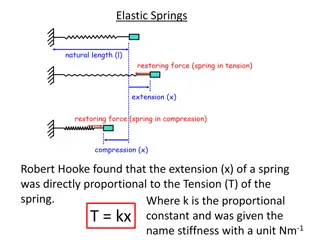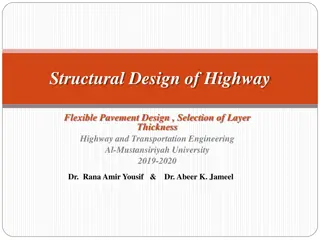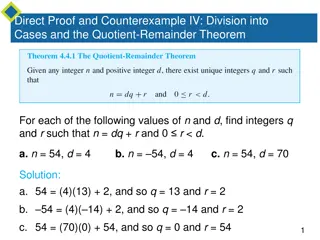AASHTO Method for Determining Effective Roadbed Soil Resilient Modulus
The AASHTO method provides a systematic approach for evaluating the effective roadbed soil resilient modulus in flexible pavements. It involves calculating the relative damage to pavements based on predicted traffic load and allowable load repetitions. The method considers the seasonal moduli values to determine the effective modulus for designing durable highway pavements.
Download Presentation

Please find below an Image/Link to download the presentation.
The content on the website is provided AS IS for your information and personal use only. It may not be sold, licensed, or shared on other websites without obtaining consent from the author. Download presentation by click this link. If you encounter any issues during the download, it is possible that the publisher has removed the file from their server.
E N D
Presentation Transcript
Structural Design of Highway Flexible Pavement Design Highway and Transportation Engineering Al-Mustansiriyah University 2019-2020 Dr. Rana Amir Yousif & Dr. Abeer K. Jameel Yoder; E. J. and M. W. Witczak, Principles of Pavement Design , A Wiley- Interscience Publication, John Wiley & Sons Inc., U.S.A., 1975.
References Nicholas J. Garber and Lester A. Hoel. Traffic and Highway Engineering , Fourth Edition. Yoder; E. J. and M. W. Witczak, Principles of Pavement Design , A Wiley- Interscience Publication, John Wiley & Sons Inc., U.S.A., 1975. Yaug H. Huang, Pavement Analysis and Design , Prentic Hall Inc., U.S.A., 1993. AASHTO Guide for Design of Pavement Structures 1993 , AASHTO, American Association of State Highway and Transportation Officials, U.S.A., 1993. Oglesby Clarkson H., Highway Engineering , John Wiley & Sons Inc., U.S.A., 1975. Yoder; E. J. and M. W. Witczak, Principles of Pavement Design , A Wiley- Interscience Publication, John Wiley & Sons Inc., U.S.A., 1975.
11.3 AASHTO METHOD 11.3.3 Effective Roadbed Soil Resilient Modulus The effective roadbed soil resilient modulus is an equivalent modulus that would result in the same damage if seasonal modulus values were actually used . The equation for evaluating the relative damage to flexible pavements and the method for computing are discussed next . Relative Damage: From Eq.11.37, the effect of MR on W18 can be expressed as in which log C is the sum of all but the last two terms in Eq.11.37 . Equation 1138 can be written as Yoder; E. J. and M. W. Witczak, Principles of Pavement Design , A Wiley- Interscience Publication, John Wiley & Sons Inc., U.S.A., 1975.
11.3 AASHTO METHOD 11.3.3 Effective Roadbed Soil Resilient Modulus If WT is the predicted total traffic, the damage ratio, which is a ratio between predicted and allowable number of load repetitions, can be expressed as. If WT is uniformly distributed over n periods, the cumulative damage ratio is Yoder; E. J. and M. W. Witczak, Principles of Pavement Design , A Wiley- Interscience Publication, John Wiley & Sons Inc., U.S.A., 1975.
11.3 AASHTO METHOD 11.3.3 Effective Roadbed Soil Resilient Modulus Equating Eq.11.40 to Eq.11.41 gives: Equation 11 .42 can be used to determine the effective roadbed soil resilient modulus MR in terms of seasonal moduli MRi . Although the coefficient can be canceled out to simplify the equation, the AASHTO design guide keeps the coefficient and defines the relative damage as Yoder; E. J. and M. W. Witczak, Principles of Pavement Design , A Wiley- Interscience Publication, John Wiley & Sons Inc., U.S.A., 1975.
11.3 AASHTO METHOD 11 .3.3 Effective Roadbed Soil Resilient Modulus Computation of Effective Roadbed Soil Resilient Modulus Figure 11.26 is a worksheet for estimating effective roadbed soil resilient modulus, in which Eq.11.43, together with a vertical scale for graphical solution of , is also shown . A year is divided into a number of periods during which different roadbed soil resilient moduli are specified. The shortest time period is half a month . These seasonal moduli can be determined from correlations with soil moisture and temperature conditions or from nondestructive deflection testing. Yoder; E. J. and M. W. Witczak, Principles of Pavement Design , A Wiley- Interscience Publication, John Wiley & Sons Inc., U.S.A., 1975.
11.3 AASHTO METHOD 11.3.3 Effective Roadbed Soil Resilient Modulus Effective Roadbed Soil Resilient Modulus, MR (psi) = 2,200 (corresponds to ) FIGURE 11.26 Worksheet for estimating effective roadbed soil resilient modulus (1 psi = 6 .9 kPa) . Yoder; E. J. and M. W. Witczak, Principles of Pavement Design , A Wiley- Interscience Publication, John Wiley & Sons Inc., U.S.A., 1975.
11.3 AASHTO METHOD 11.3.4 Structural Number Structural number is a function of layer thicknesses, layer coefficients, and drainage coefficients and can be computed from Eq.11.35 Layer Coefficient The layer coefficient , is a measure of the relative ability of a unit thickness of a given material to function as a structural component of the pavement. Layer coefficients can be determined from test roads or satellite sections, as was done in the AASHO Road Test, or from correlations with material properties, as was shown in Figures 7.13, 7.15, and 7.16 . Yoder; E. J. and M. W. Witczak, Principles of Pavement Design , A Wiley- Interscience Publication, John Wiley & Sons Inc., U.S.A., 1975.
FIGURE 7.13 Correlation charts for estimating resilient modulus of HMA (1 lb = 4.45 N, 1 psi = 6 .9 kPa) . (After Van Til et al. (1972) ) 11.3 AASHTO METHOD 11.3.4 Structural Number Yoder; E. J. and M. W. Witczak, Principles of Pavement Design , A Wiley- Interscience Publication, John Wiley & Sons Inc., U.S.A., 1975.
FIGURE 7.15 Correlation charts for estimating resilient modulus of bases (1 lb = 4 .45 KN, 1 psi = 6.9 kPa) . (After Van Til et al . (1972) ) 11.3 AASHTO METHOD 11.3.4 Structural Number Yoder; E. J. and M. W. Witczak, Principles of Pavement Design , A Wiley- Interscience Publication, John Wiley & Sons Inc., U.S.A., 1975.
FIGURE 7.16 Correlation chart for estimating resilient modulus of subbases (1 psi = 6 .9 kPa) . (After Van Til et al. (1972)) 11.3 AASHTO METHOD 11.3.4 Structural Number Yoder; E. J. and M. W. Witczak, Principles of Pavement Design , A Wiley- Interscience Publication, John Wiley & Sons Inc., U.S.A., 1975.
11.3 AASHTO METHOD 11.3.4 Structural Number It is recommended that the layer coefficient be based on the resilient modulus, which is a more fundamental material property. The procedure for determining the resilient modulus of a particular material varies with its type . Except for the higher stiffness materials, such as HMA and stabilized bases, that may be tested by the repeated load indirect tensile test (ASTM D-4123), all materials should be tested by the resilient modulus test methods (AASHTO T274) . Methods for determining the resilient modulus were described in Section 7.1. In following the AASHTO design guide, the notation MR, as used herein, refers only to roadbed soils, whereas El , E2 , and E3 apply to the HMA, base, and sub-base, respectively. Yoder; E. J. and M. W. Witczak, Principles of Pavement Design , A Wiley- Interscience Publication, John Wiley & Sons Inc., U.S.A., 1975.
11.3 AASHTO METHOD 11.3.4 Structural Number Asphalt - Concrete Surface Course: Figure 11.27 is a chart relating the layer coefficient of a dense-graded HMA to its resilient modulus at 70 F (21 C) . FIGURE 11 .2 7 Chart for estimating layer coefficient of dense-graded asphalt concrete based on elastic modulus (1 psi = 6.9 kPa) . (After Van Til et al. (1972) ) MR=3 Yoder; E. J. and M. W. Witczak, Principles of Pavement Design , A Wiley- Interscience Publication, John Wiley & Sons Inc., U.S.A., 1975.
11.3 AASHTO METHOD 11.3.4 Structural Number Untreated and Stabilized Base Courses: Figure 7.15 shows the charts that can be used to estimate the layer coefficient for untreated, bituminous-treated, and cement-treated base courses . In lieu of Figure 7.15a, the following equation can also be used to estimate for an untreated base course from its resilient modulus : The layer coefficient for the granular base material used in the AASHO Road Test is 0.14, which corresponds to a base resilient modulus of 30,000 psi (207 GPa) . The resilient modulus of untreated granular materials depends on the stress state , as indicated by Eq.3.8 and rewritten here as Yoder; E. J. and M. W. Witczak, Principles of Pavement Design , A Wiley- Interscience Publication, John Wiley & Sons Inc., U.S.A., 1975.
11.3 AASHTO METHOD 11.3.4 Structural Number The resilient modulus of the base course is a function not only of Kl and K2 , but also of the stress state . Yoder; E. J. and M. W. Witczak, Principles of Pavement Design , A Wiley- Interscience Publication, John Wiley & Sons Inc., U.S.A., 1975.
11.3 AASHTO METHOD 11.3.4 Structural Number Granular Sub-base Course : Figure 7.16 provides the chart that may be used to estimate layer coefficient of granular sub-base courses. The relationship between and can be expressed as As with granular base courses, values of Kl and K2 for granular sub-base courses can be determined from the resilient modulus test (AASHTO T274) or estimated from Table11.18. Values of K1 , K2, , and E3 for the sub-base in the AASHO Road Test are shown in Table 11.19 . Yoder; E. J. and M. W. Witczak, Principles of Pavement Design , A Wiley- Interscience Publication, John Wiley & Sons Inc., U.S.A., 1975.
11.3 AASHTO METHOD 11.3.4 Structural Number Yoder; E. J. and M. W. Witczak, Principles of Pavement Design , A Wiley- Interscience Publication, John Wiley & Sons Inc., U.S.A., 1975.
11.3 AASHTO METHOD 11.3.4 Structural Number Drainage Coefficient : Depending on the quality of drainage and the availability o f moisture, drainage coefficients m2 and m3 should be applied to granular bases and sub - bases to modify the layer coefficients, as shown in Eq.11.35. At the AASHTO Road Test site, these drainage coefficients are all equal to 1, as indicated by Eq.11.32. Yoder; E. J. and M. W. Witczak, Principles of Pavement Design , A Wiley- Interscience Publication, John Wiley & Sons Inc., U.S.A., 1975.
Table 11.20 shows the recommended drainage coefficients for untreated base and subbase materials in flexible pavements . The quality of drainage is measured by the length of time for water to be removed from bases and subbases and depends primarily on their permeability. The percentage of time during which the pavement structure is exposed to moisture levels approaching saturation depends on the average yearly rain fall and the prevailing drainage conditions . 11.3 AASHTO METHOD 11.3.4 Structural Number Yoder; E. J. and M. W. Witczak, Principles of Pavement Design , A Wiley- Interscience Publication, John Wiley & Sons Inc., U.S.A., 1975.
11.3 AASHTO METHOD 11.3.5 Selection of Layer Thicknesses Once the design structural number SN for an initial pavement structure is determined , it is necessary to select a set of thicknesses so that the provided SN, as computed by Eq.11.35, will be greater than the required SN. Note that Eq.11.35 does not have a single unique solution . Many combinations of layer thicknesses are acceptable, so their cost effectiveness along with the construction and maintenance constraints must be considered to avoid the possibility of producing an impractical design . From a cost-effective view point, if the ratio of costs for HMA and granular base is less than the corresponding ratio of layer coefficients times the drainage coefficient, then the optimum economical design is to use a minimum base thickness by increasing the HMA thickness . Yoder; E. J. and M. W. Witczak, Principles of Pavement Design , A Wiley- Interscience Publication, John Wiley & Sons Inc., U.S.A., 1975.
11.3 AASHTO METHOD 11.3.5 Selection of Layer Thicknesses Minimum Thickness It is generally impractical and uneconomical to use layers of material that are less than some minimum thickness . Furthermore, traffic considerations may dictate the use of a certain minimum thickness for stability . Table 11.21 shows thicknesses of asphalt surface and aggregate base . Because such minimums depend somewhat on local practices and conditions, they may be changed if needed. the minimum Yoder; E. J. and M. W. Witczak, Principles of Pavement Design , A Wiley- Interscience Publication, John Wiley & Sons Inc., U.S.A., 1975.
11.3 AASHTO METHOD 11.3.5 Selection of Layer Thicknesses General Procedure The procedure for thickness design is usually started from the top, as shown in Figure 11.28 and described as follows: Yoder; E. J. and M. W. Witczak, Principles of Pavement Design , A Wiley- Interscience Publication, John Wiley & Sons Inc., U.S.A., 1975.
11.3 AASHTO METHOD 11.3.5 Selection of Layer Thicknesses 1. Using E2 as MR, determine from Figure 11.25 the structural number SN1 required to protect the base, and compute the thickness of layer 1 from Step 1 2. Using E3 as MR, determine from Figure 11.25 the structural number SN2 required to protect the sub-base, and compute the thickness of layer 2 from Step 2 Yoder; E. J. and M. W. Witczak, Principles of Pavement Design , A Wiley- Interscience Publication, John Wiley & Sons Inc., U.S.A., 1975.
11.3 AASHTO METHOD 11.3.5 Selection of Layer Thicknesses 3. Based on the roadbed soil resilient modulus MR, determine from Figure 11.25 the total structural number SN3 required, and compute the thickness of layer 3 from Step 3 Yoder; E. J. and M. W. Witczak, Principles of Pavement Design , A Wiley- Interscience Publication, John Wiley & Sons Inc., U.S.A., 1975.
11.3 AASHTO METHOD 11.3.5 Selection of Layer Thicknesses Example 11.12 : Figure 11.29 is a pavement system with the resilient moduli, layer coefficients, and drainage coefficients as shown . If predicted ESAL = 18.6 * R = 95%, So = 0.35 and PSI = 2.1 select thicknesses Dl , D2 , and D3 . FIGURE 11 .2 9 Example 11 .12 (1 psi = 6 .9 kPa) . Yoder; E. J. and M. W. Witczak, Principles of Pavement Design , A Wiley- Interscience Publication, John Wiley & Sons Inc., U.S.A., 1975.
Solution : with 11.3 AASHTO METHOD 11.3.5 Selection of Layer Thicknesses Yoder; E. J. and M. W. Witczak, Principles of Pavement Design , A Wiley- Interscience Publication, John Wiley & Sons Inc., U.S.A., 1975.
11.3 AASHTO METHOD 11.3.5 Selection of Layer Thicknesses Note that a surface thickness of 8 in . (203 mm) and a base thickness of 7 in . (178 mm) meet the minimum thicknesses shown in Table11.21 . Yoder; E. J. and M. W. Witczak, Principles of Pavement Design , A Wiley- Interscience Publication, John Wiley & Sons Inc., U.S.A., 1975.
11.3 AASHTO METHOD 11.3.5 Selection of Layer Thicknesses Yoder; E. J. and M. W. Witczak, Principles of Pavement Design , A Wiley- Interscience Publication, John Wiley & Sons Inc., U.S.A., 1975.
11.3 AASHTO METHOD 11.3.5 Selection of Layer Thicknesses Yoder; E. J. and M. W. Witczak, Principles of Pavement Design , A Wiley- Interscience Publication, John Wiley & Sons Inc., U.S.A., 1975.
Structural Design of Highway Dr. Rana Amir Yousif & Dr. Abeer K. Jameel Yoder; E. J. and M. W. Witczak, Principles of Pavement Design , A Wiley- Interscience Publication, John Wiley & Sons Inc., U.S.A., 1975.























